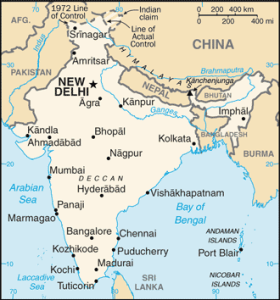Importing from India


India Country Profile
Official Name (Local Language) Bharatiya Ganarajya
Capital New Delhi
Population 1,266,883,598
Currency Indian Rupee
GDP $2,251 billion
Languages English, Hindi
Telephone Dial In 91
India Exports Profile
Exports ($m USD) 294,364
Number of Export Products 4,418
Number of Export Partners 219

China Economic Statistics
Government Website | https://www.india.gov.in/ |
| Sovereign Ratings | https://countryeconomy. com/ratings/india |
| Central Bank | Reserve Bank of India |
| Currency USD Exchange Rate | 68.3 |
| Unemployment Rate | 2.7% |
| Population below poverty line | NA |
| Inflation Rate | 1.9% |
| Prime Lending Rate | 5.4% |
| GDP | $2,251 billion |
| GDP Pro Capita (PPP) | $6,700 |
| Currency Name | Indian Rupee |
| Currency Code | INR |
| World Bank Classification | Lower Middle Income |
| Competitive Industrial Performance | 39/138 |
| Corruption Perceptions Index | 81/180 |
| Ease of Doing Business | 77/190 |
| Enabling Trade Index | 102/136 |
Access trade, receivables and supply chain finance
We assist companies to access trade and receivables finance through our relationships with 270+ banks, funds and alternative finance houses.
Get StartedImporting from India
India is one of the fastest growing economies in the world with growth rates reaching 9% in recent years. India is being targeted by investors for major growth in a number of areas including life sciences, infrastructure, energy and manufacturing. It is predicted to be the world’s third largest economy and largest middle class consumer market by 2030. Exports from India have grown at a rapid rate, climbing from $179 billion in 2010 to $310 billion a year. Over the same period the export to GDP ratio increased from 13.3% to 15.6%, demonstrating the importance of exports to the growing economy. The foreign trade policy of the national government is looking to build on this success, aiming to increase exports to $900 billion by 2020.
Importing from India: What is trade finance?
Stock finance is a revolving facility which alternative lenders offer – it enables organisations to buy stock and can help ease the pressure from cash management. Typically, an alternative financier will fund most of the cost of the stock, including charges (e.g. insurance costs). Trade finance offers advantages over more traditional bank funding for example invoice finance or business loans. Trade finance provides quick funding without affecting existing relationships with banks.
How does it work?
If you’re a company importing or exporting inventory outside of your own country, then a trade finance facility would allow you to fund this through offering a LC (letter of credit) or some form of cash advance.
I’m looking to import from India, how can Trade Finance Global help, and how does it work?
If you’re looking to import from India, contact our local experts in trade finance to see how we can help you grow your business in other markets. If you are looking to import stock from other countries, you may need import finance, which is an agreement between yourself (the importer) and the foreign exporter. A non-bank lender will act as the intermediary, paying the foreign exporter on your behalf until you receive the goods and have then sold them to your customer. Repaying the financier then occurs over an agreed period. Read the TFG Importers Guide here.
Chart Showing GDP Growth Compared to rest of world
GDP Composition for India
Agriculture
16.5%
Rice, wheat, oilseed, cotton, jute, tea, sugarcane, lentils, onions, potatoes; dairy products, sheep, goats, poultry; fish
Industry
29.8%
Textiles, chemicals, food processing, steel, transportation equipment, cement, mining, petroleum, machinery, software, pharmaceuticals
Services
45.4%
Map
Top 5 Exports Partners
| Country | Trade | % Partner Share |
| United States | 46,018 | 15.63 |
| United Arab Emirates | 28,636 | 9.73 |
| Hong Kong, China | 15,021 | 5.10 |
| China | 12,495 | 4.24 |
| Singapore | 11,560 | 3.93 |
Top 5 Exports Products
| Export Product | Number |
| Petroleum oils, etc, (excl. crude); preparation | 11.8% |
| Diamonds non-industrial nes excluding mounted o | 8.4% |
| Other medicaments of mixed or unmixed products, | 4.3% |
| Art. of jewellery and pts thereof of/o prec mtl | 3.9% |
| Semi-milled or wholly milled rice | 2.4% |
Local Authors
Local Partners
- All Topics
- Indian Trade Resources
- Export Finance and ECA Topics
- Local Conferences






















